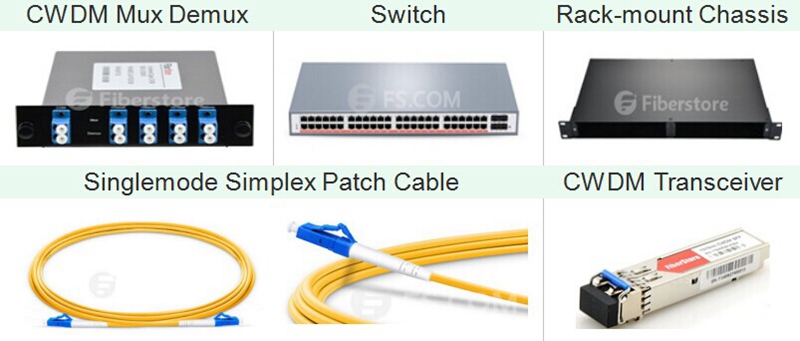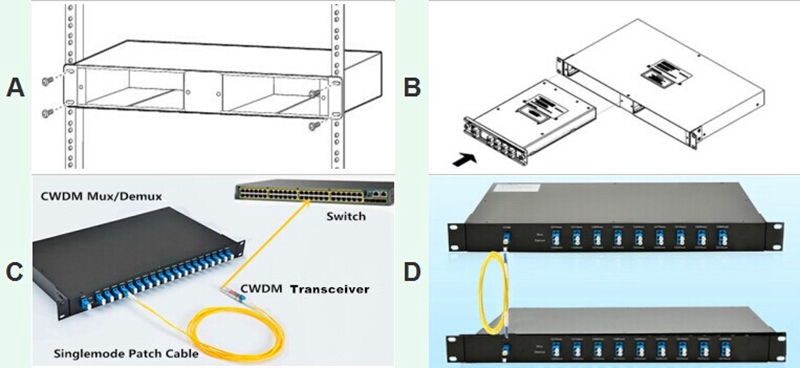Generally, CWDM network designed for expanding the network capacity can be basically divided into two types, dual-fiber and single-fiber CWDM network, according to the optical fiber transmission line. For the dual-fiber CWDM network, its working principle is easy to acquire, which uses the same wavelength for transmitting and receiving each pair of dual-way signals over the duplex fiber cable. However, for the single-fiber CWDM network, the working principle is highly complex that specially works with different wavelengths for transmitting and receiving each pair of dual-way signals over only one fiber. To better understand the single-fiber CWDM network, here will mainly illustrate how does a single-fiber CWDM network work and introduce the components and installation steps for fast deploying a single-fiber CWDM network.
Single-fiber CWDM network is a kind of WDM network, designed for greatly expanding the network capacity by combining and transmitting several pairs of dual-way signals with different wavelengths over a single fiber, instead of putting more fibers for lager dual-way data transmission need. When the single-fiber CWDM network runs, there are two single-fiber CWDM Mux Demux using two different wavelengths for each pair of dual-way transmission. In details, if the single-fiber CWDM Mux Demux has four channels for dual-way data transmission, then eight different wavelengths divided into four pairs are required for the four channels, as shown in the figure below. To make a comparison, a 4 channel dual-fiber CWDM Mux Demux only needs four different wavelengths for the dual-way transmission.
From the figure above, we can learn that a 4 channel CWDM network needs two reliable 4 channel CWDM Mux Demux connected by a single fiber and four pairs of CWDM transceivers with eight different wavelengths connected to the CWDM Mux Demux, achieving the dual-way transmission. Obviously, each port of the two CWDM Mux Demux for the same channel has the complete reversed TX and RX. Just taking the first channel as example, the first port of the CWDM Mux Demux on the left side uses 1470nm for TX and 1490nm for RX, while the first port on the right side uses 1490nm for TX and 1470nm for RX, reversely. Hence, each pair of dual-way signals with two different wavelengths will be smoothly transmitted and received. To better understand how does the single fiber CWDM network work, the following table also lists the four pairs of wavelengths for the TX and RX ports of the two CWDM Mux Demux, which are also totally reversed.
When deploy the single-fiber CWDM network, we should prepare two single-fiber CWDM Mux Demux, two switches, a rack-mount chassis, several pairs of CWDM transceivers and singlemode simplex patch cables that are the basic and essential components for a single-fiber CWDM network. The two switches separately act as the Local unit and Remote unit for the CWDM network, while the CWDM Mux Demux is the main unit of the network that should be fixed and held on the rack-mount chassis and then connected to the switch. To finish the connection between the CWDM Mux Demux and switch, we should insert the CWDM transceivers into the ports of CWDM Mux Demux and use the singlemode simplex patch cables to connect CWDM transceivers with the switch.
To fast deploy a single-fiber CWDM network, here offers the step by step installation procedure.
Step A: Install the rack-mount chassis in a standard 19-inch cabinet or rack.
Step B: Align the single-fiber CWDM Mux Demux with the chassis shelf, slightly push it to the shelf cavity. And tighten the captive screws once the CWDM Mux Demux is totally inserted.
Step C: Plug the CWDM transceivers into the switch. And also, connect these CWDM transceivers to the corresponding ports on CWDM Mux Demux according to the wavelengths of the TX and RX, with the use of singlemode simplex patch cable.
Step D: Utilize the singlemode simplex patch cable to connect the two CWDM Mux Demux and test the performance of the whole single-fiber CWDM network.
Single-fiber CWDM network is a cost-effective and easy-to-deploy solution that can not only take full use of the available fiber bandwidth in your network but also greatly expand your network capacity. If you are hesitating over upgrading your system for bigger capacity, buy CWDM multi-channel Mux/Demux, CWDM transceivers and other basic components to deploy the single-fiber CWDM network would be a better choice for you.



